Analysis of Code Blue Scenario: Complex Care Media Annotation
VerifiedAdded on 2021/06/17
|11
|3276
|29
Report
AI Summary
This report presents a detailed media annotation of a 'Code Blue, Full code' video scenario, focusing on the actions of medical professionals during a resuscitation attempt. The analysis critically examines adherence to the Australian Resuscitation Council (ANC) guidelines, identifying both effective practices and instances of underperformance or missed steps. The report highlights key aspects such as initial assessment, airway management, CPR techniques, defibrillation procedures, medication administration, and family involvement. It compares the observed actions with the recommendations outlined in various ANC guidelines, including those related to managing emergencies, recognizing unconsciousness, airway management, chest compressions, defibrillation, and medication protocols. The report also provides recommendations for improving patient care and ensuring compliance with ANC guidelines, emphasizing the importance of prompt action, accurate assessment, proper technique, and adherence to established protocols to optimize patient outcomes. The report also analyzes deviations from recommended energy levels in defibrillation and the importance of timely administration of medications, along with the significance of family presence during resuscitation.
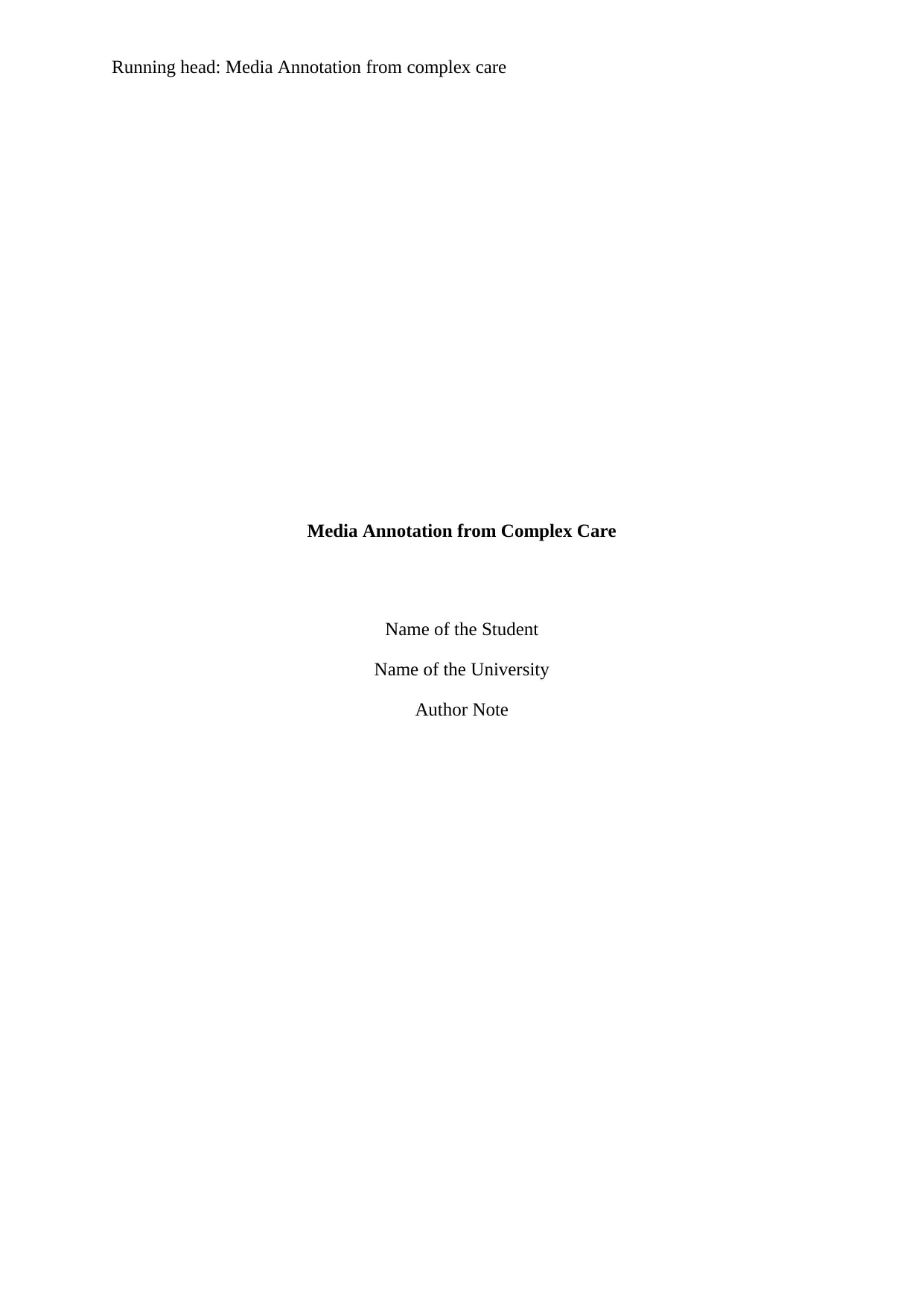
Running head: Media Annotation from complex care
Media Annotation from Complex Care
Name of the Student
Name of the University
Author Note
Media Annotation from Complex Care
Name of the Student
Name of the University
Author Note
Paraphrase This Document
Need a fresh take? Get an instant paraphrase of this document with our AI Paraphraser
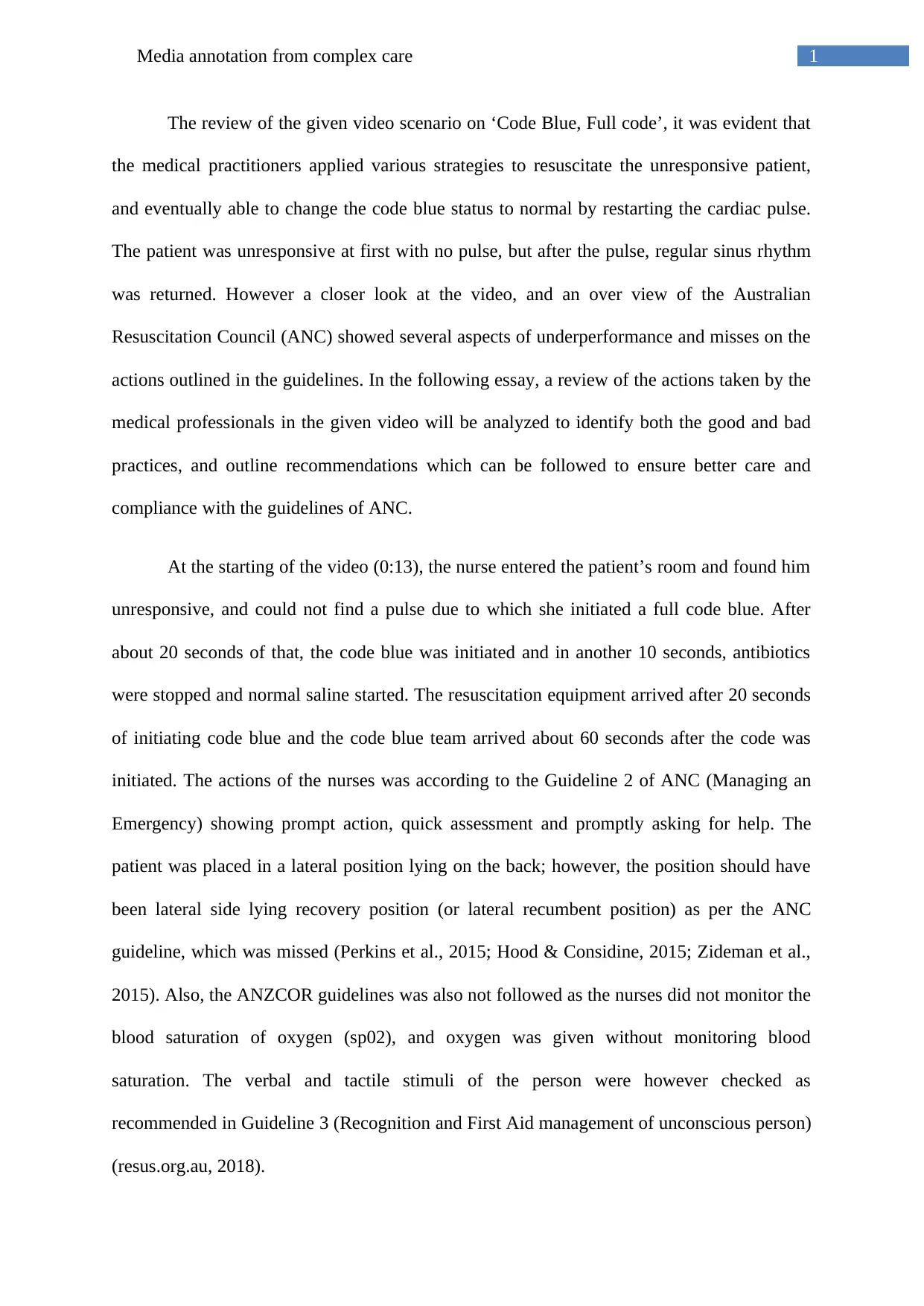
1Media annotation from complex care
The review of the given video scenario on ‘Code Blue, Full code’, it was evident that
the medical practitioners applied various strategies to resuscitate the unresponsive patient,
and eventually able to change the code blue status to normal by restarting the cardiac pulse.
The patient was unresponsive at first with no pulse, but after the pulse, regular sinus rhythm
was returned. However a closer look at the video, and an over view of the Australian
Resuscitation Council (ANC) showed several aspects of underperformance and misses on the
actions outlined in the guidelines. In the following essay, a review of the actions taken by the
medical professionals in the given video will be analyzed to identify both the good and bad
practices, and outline recommendations which can be followed to ensure better care and
compliance with the guidelines of ANC.
At the starting of the video (0:13), the nurse entered the patient’s room and found him
unresponsive, and could not find a pulse due to which she initiated a full code blue. After
about 20 seconds of that, the code blue was initiated and in another 10 seconds, antibiotics
were stopped and normal saline started. The resuscitation equipment arrived after 20 seconds
of initiating code blue and the code blue team arrived about 60 seconds after the code was
initiated. The actions of the nurses was according to the Guideline 2 of ANC (Managing an
Emergency) showing prompt action, quick assessment and promptly asking for help. The
patient was placed in a lateral position lying on the back; however, the position should have
been lateral side lying recovery position (or lateral recumbent position) as per the ANC
guideline, which was missed (Perkins et al., 2015; Hood & Considine, 2015; Zideman et al.,
2015). Also, the ANZCOR guidelines was also not followed as the nurses did not monitor the
blood saturation of oxygen (sp02), and oxygen was given without monitoring blood
saturation. The verbal and tactile stimuli of the person were however checked as
recommended in Guideline 3 (Recognition and First Aid management of unconscious person)
(resus.org.au, 2018).
The review of the given video scenario on ‘Code Blue, Full code’, it was evident that
the medical practitioners applied various strategies to resuscitate the unresponsive patient,
and eventually able to change the code blue status to normal by restarting the cardiac pulse.
The patient was unresponsive at first with no pulse, but after the pulse, regular sinus rhythm
was returned. However a closer look at the video, and an over view of the Australian
Resuscitation Council (ANC) showed several aspects of underperformance and misses on the
actions outlined in the guidelines. In the following essay, a review of the actions taken by the
medical professionals in the given video will be analyzed to identify both the good and bad
practices, and outline recommendations which can be followed to ensure better care and
compliance with the guidelines of ANC.
At the starting of the video (0:13), the nurse entered the patient’s room and found him
unresponsive, and could not find a pulse due to which she initiated a full code blue. After
about 20 seconds of that, the code blue was initiated and in another 10 seconds, antibiotics
were stopped and normal saline started. The resuscitation equipment arrived after 20 seconds
of initiating code blue and the code blue team arrived about 60 seconds after the code was
initiated. The actions of the nurses was according to the Guideline 2 of ANC (Managing an
Emergency) showing prompt action, quick assessment and promptly asking for help. The
patient was placed in a lateral position lying on the back; however, the position should have
been lateral side lying recovery position (or lateral recumbent position) as per the ANC
guideline, which was missed (Perkins et al., 2015; Hood & Considine, 2015; Zideman et al.,
2015). Also, the ANZCOR guidelines was also not followed as the nurses did not monitor the
blood saturation of oxygen (sp02), and oxygen was given without monitoring blood
saturation. The verbal and tactile stimuli of the person were however checked as
recommended in Guideline 3 (Recognition and First Aid management of unconscious person)
(resus.org.au, 2018).
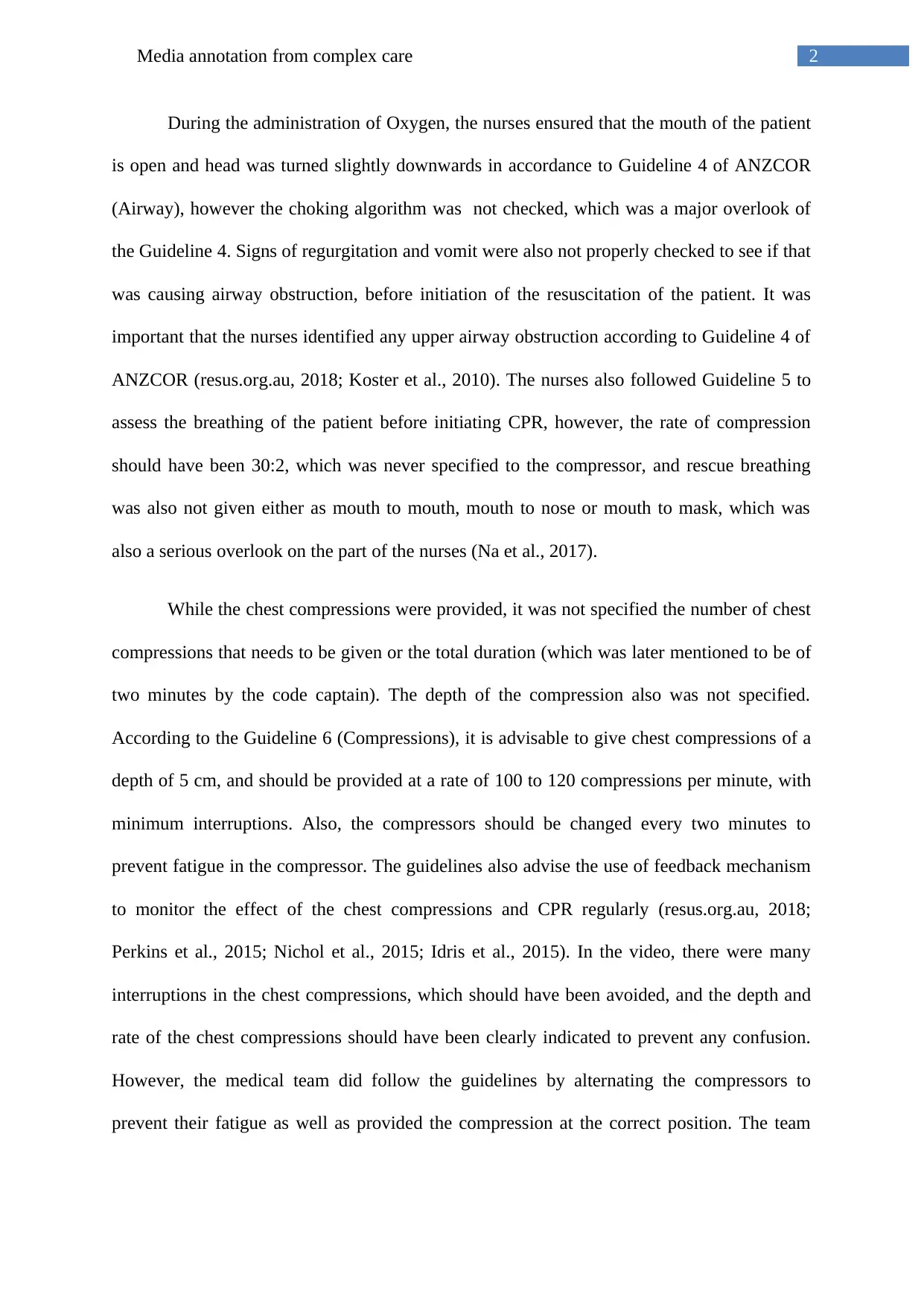
2Media annotation from complex care
During the administration of Oxygen, the nurses ensured that the mouth of the patient
is open and head was turned slightly downwards in accordance to Guideline 4 of ANZCOR
(Airway), however the choking algorithm was not checked, which was a major overlook of
the Guideline 4. Signs of regurgitation and vomit were also not properly checked to see if that
was causing airway obstruction, before initiation of the resuscitation of the patient. It was
important that the nurses identified any upper airway obstruction according to Guideline 4 of
ANZCOR (resus.org.au, 2018; Koster et al., 2010). The nurses also followed Guideline 5 to
assess the breathing of the patient before initiating CPR, however, the rate of compression
should have been 30:2, which was never specified to the compressor, and rescue breathing
was also not given either as mouth to mouth, mouth to nose or mouth to mask, which was
also a serious overlook on the part of the nurses (Na et al., 2017).
While the chest compressions were provided, it was not specified the number of chest
compressions that needs to be given or the total duration (which was later mentioned to be of
two minutes by the code captain). The depth of the compression also was not specified.
According to the Guideline 6 (Compressions), it is advisable to give chest compressions of a
depth of 5 cm, and should be provided at a rate of 100 to 120 compressions per minute, with
minimum interruptions. Also, the compressors should be changed every two minutes to
prevent fatigue in the compressor. The guidelines also advise the use of feedback mechanism
to monitor the effect of the chest compressions and CPR regularly (resus.org.au, 2018;
Perkins et al., 2015; Nichol et al., 2015; Idris et al., 2015). In the video, there were many
interruptions in the chest compressions, which should have been avoided, and the depth and
rate of the chest compressions should have been clearly indicated to prevent any confusion.
However, the medical team did follow the guidelines by alternating the compressors to
prevent their fatigue as well as provided the compression at the correct position. The team
During the administration of Oxygen, the nurses ensured that the mouth of the patient
is open and head was turned slightly downwards in accordance to Guideline 4 of ANZCOR
(Airway), however the choking algorithm was not checked, which was a major overlook of
the Guideline 4. Signs of regurgitation and vomit were also not properly checked to see if that
was causing airway obstruction, before initiation of the resuscitation of the patient. It was
important that the nurses identified any upper airway obstruction according to Guideline 4 of
ANZCOR (resus.org.au, 2018; Koster et al., 2010). The nurses also followed Guideline 5 to
assess the breathing of the patient before initiating CPR, however, the rate of compression
should have been 30:2, which was never specified to the compressor, and rescue breathing
was also not given either as mouth to mouth, mouth to nose or mouth to mask, which was
also a serious overlook on the part of the nurses (Na et al., 2017).
While the chest compressions were provided, it was not specified the number of chest
compressions that needs to be given or the total duration (which was later mentioned to be of
two minutes by the code captain). The depth of the compression also was not specified.
According to the Guideline 6 (Compressions), it is advisable to give chest compressions of a
depth of 5 cm, and should be provided at a rate of 100 to 120 compressions per minute, with
minimum interruptions. Also, the compressors should be changed every two minutes to
prevent fatigue in the compressor. The guidelines also advise the use of feedback mechanism
to monitor the effect of the chest compressions and CPR regularly (resus.org.au, 2018;
Perkins et al., 2015; Nichol et al., 2015; Idris et al., 2015). In the video, there were many
interruptions in the chest compressions, which should have been avoided, and the depth and
rate of the chest compressions should have been clearly indicated to prevent any confusion.
However, the medical team did follow the guidelines by alternating the compressors to
prevent their fatigue as well as provided the compression at the correct position. The team
⊘ This is a preview!⊘
Do you want full access?
Subscribe today to unlock all pages.

Trusted by 1+ million students worldwide
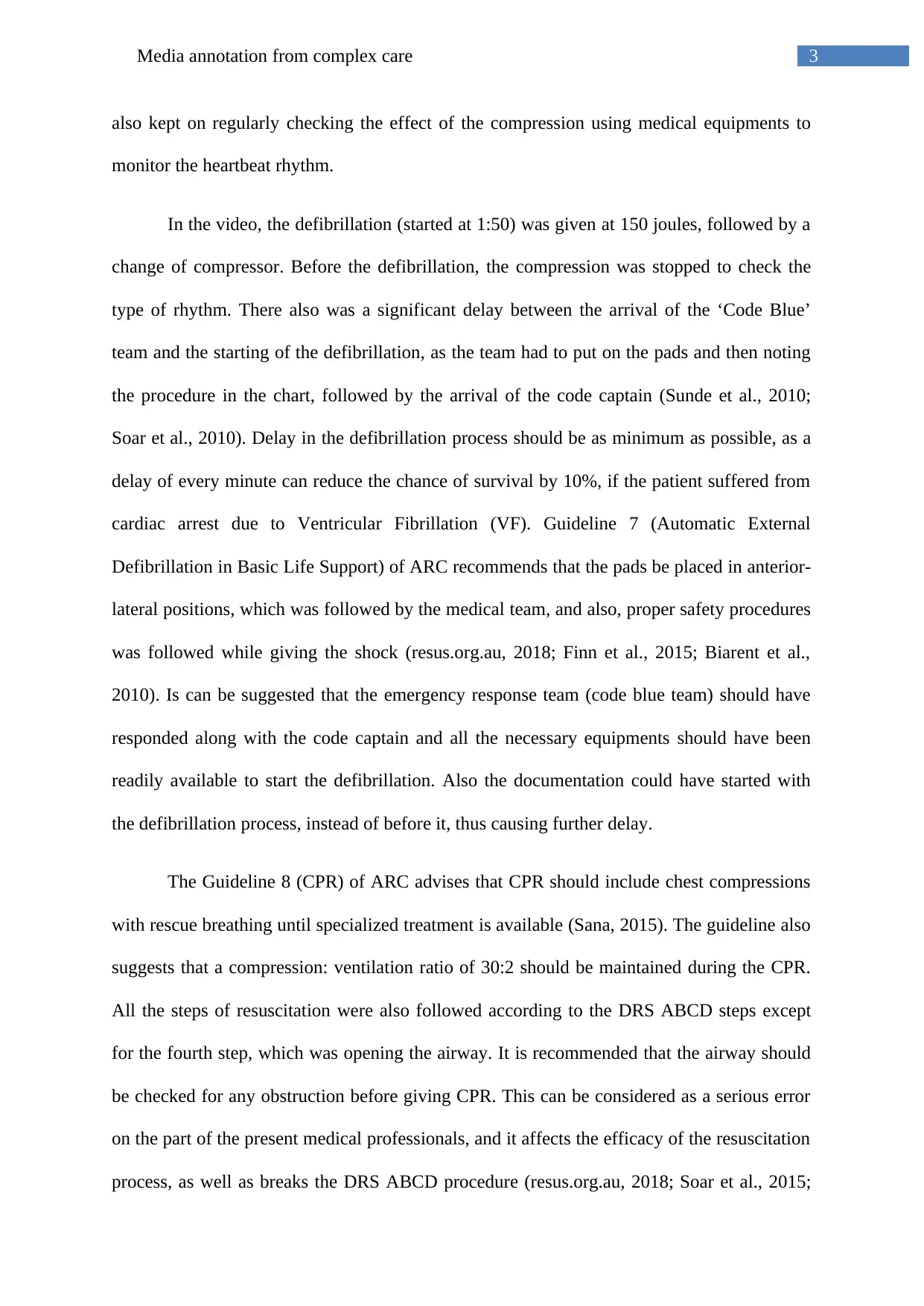
3Media annotation from complex care
also kept on regularly checking the effect of the compression using medical equipments to
monitor the heartbeat rhythm.
In the video, the defibrillation (started at 1:50) was given at 150 joules, followed by a
change of compressor. Before the defibrillation, the compression was stopped to check the
type of rhythm. There also was a significant delay between the arrival of the ‘Code Blue’
team and the starting of the defibrillation, as the team had to put on the pads and then noting
the procedure in the chart, followed by the arrival of the code captain (Sunde et al., 2010;
Soar et al., 2010). Delay in the defibrillation process should be as minimum as possible, as a
delay of every minute can reduce the chance of survival by 10%, if the patient suffered from
cardiac arrest due to Ventricular Fibrillation (VF). Guideline 7 (Automatic External
Defibrillation in Basic Life Support) of ARC recommends that the pads be placed in anterior-
lateral positions, which was followed by the medical team, and also, proper safety procedures
was followed while giving the shock (resus.org.au, 2018; Finn et al., 2015; Biarent et al.,
2010). Is can be suggested that the emergency response team (code blue team) should have
responded along with the code captain and all the necessary equipments should have been
readily available to start the defibrillation. Also the documentation could have started with
the defibrillation process, instead of before it, thus causing further delay.
The Guideline 8 (CPR) of ARC advises that CPR should include chest compressions
with rescue breathing until specialized treatment is available (Sana, 2015). The guideline also
suggests that a compression: ventilation ratio of 30:2 should be maintained during the CPR.
All the steps of resuscitation were also followed according to the DRS ABCD steps except
for the fourth step, which was opening the airway. It is recommended that the airway should
be checked for any obstruction before giving CPR. This can be considered as a serious error
on the part of the present medical professionals, and it affects the efficacy of the resuscitation
process, as well as breaks the DRS ABCD procedure (resus.org.au, 2018; Soar et al., 2015;
also kept on regularly checking the effect of the compression using medical equipments to
monitor the heartbeat rhythm.
In the video, the defibrillation (started at 1:50) was given at 150 joules, followed by a
change of compressor. Before the defibrillation, the compression was stopped to check the
type of rhythm. There also was a significant delay between the arrival of the ‘Code Blue’
team and the starting of the defibrillation, as the team had to put on the pads and then noting
the procedure in the chart, followed by the arrival of the code captain (Sunde et al., 2010;
Soar et al., 2010). Delay in the defibrillation process should be as minimum as possible, as a
delay of every minute can reduce the chance of survival by 10%, if the patient suffered from
cardiac arrest due to Ventricular Fibrillation (VF). Guideline 7 (Automatic External
Defibrillation in Basic Life Support) of ARC recommends that the pads be placed in anterior-
lateral positions, which was followed by the medical team, and also, proper safety procedures
was followed while giving the shock (resus.org.au, 2018; Finn et al., 2015; Biarent et al.,
2010). Is can be suggested that the emergency response team (code blue team) should have
responded along with the code captain and all the necessary equipments should have been
readily available to start the defibrillation. Also the documentation could have started with
the defibrillation process, instead of before it, thus causing further delay.
The Guideline 8 (CPR) of ARC advises that CPR should include chest compressions
with rescue breathing until specialized treatment is available (Sana, 2015). The guideline also
suggests that a compression: ventilation ratio of 30:2 should be maintained during the CPR.
All the steps of resuscitation were also followed according to the DRS ABCD steps except
for the fourth step, which was opening the airway. It is recommended that the airway should
be checked for any obstruction before giving CPR. This can be considered as a serious error
on the part of the present medical professionals, and it affects the efficacy of the resuscitation
process, as well as breaks the DRS ABCD procedure (resus.org.au, 2018; Soar et al., 2015;
Paraphrase This Document
Need a fresh take? Get an instant paraphrase of this document with our AI Paraphraser
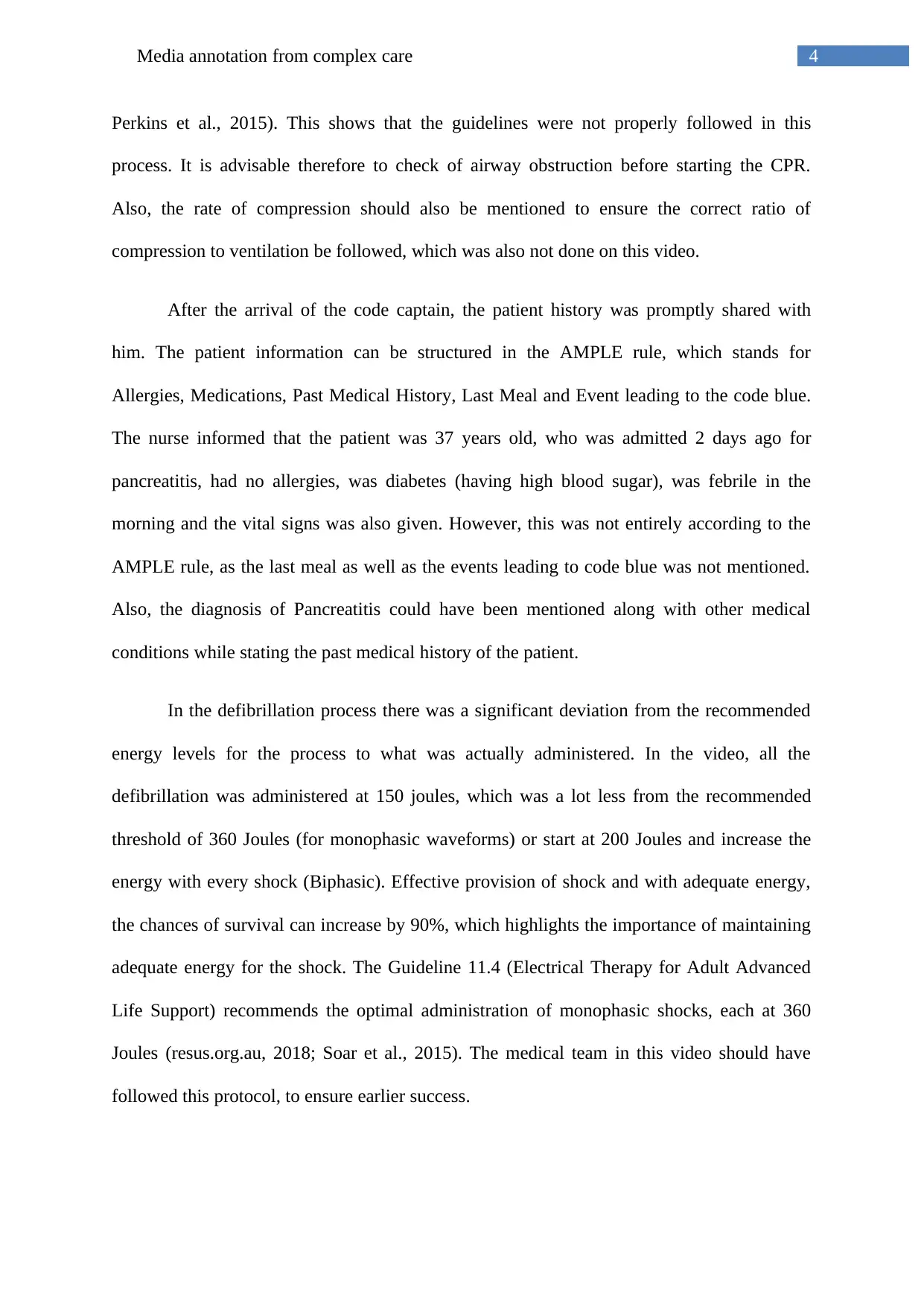
4Media annotation from complex care
Perkins et al., 2015). This shows that the guidelines were not properly followed in this
process. It is advisable therefore to check of airway obstruction before starting the CPR.
Also, the rate of compression should also be mentioned to ensure the correct ratio of
compression to ventilation be followed, which was also not done on this video.
After the arrival of the code captain, the patient history was promptly shared with
him. The patient information can be structured in the AMPLE rule, which stands for
Allergies, Medications, Past Medical History, Last Meal and Event leading to the code blue.
The nurse informed that the patient was 37 years old, who was admitted 2 days ago for
pancreatitis, had no allergies, was diabetes (having high blood sugar), was febrile in the
morning and the vital signs was also given. However, this was not entirely according to the
AMPLE rule, as the last meal as well as the events leading to code blue was not mentioned.
Also, the diagnosis of Pancreatitis could have been mentioned along with other medical
conditions while stating the past medical history of the patient.
In the defibrillation process there was a significant deviation from the recommended
energy levels for the process to what was actually administered. In the video, all the
defibrillation was administered at 150 joules, which was a lot less from the recommended
threshold of 360 Joules (for monophasic waveforms) or start at 200 Joules and increase the
energy with every shock (Biphasic). Effective provision of shock and with adequate energy,
the chances of survival can increase by 90%, which highlights the importance of maintaining
adequate energy for the shock. The Guideline 11.4 (Electrical Therapy for Adult Advanced
Life Support) recommends the optimal administration of monophasic shocks, each at 360
Joules (resus.org.au, 2018; Soar et al., 2015). The medical team in this video should have
followed this protocol, to ensure earlier success.
Perkins et al., 2015). This shows that the guidelines were not properly followed in this
process. It is advisable therefore to check of airway obstruction before starting the CPR.
Also, the rate of compression should also be mentioned to ensure the correct ratio of
compression to ventilation be followed, which was also not done on this video.
After the arrival of the code captain, the patient history was promptly shared with
him. The patient information can be structured in the AMPLE rule, which stands for
Allergies, Medications, Past Medical History, Last Meal and Event leading to the code blue.
The nurse informed that the patient was 37 years old, who was admitted 2 days ago for
pancreatitis, had no allergies, was diabetes (having high blood sugar), was febrile in the
morning and the vital signs was also given. However, this was not entirely according to the
AMPLE rule, as the last meal as well as the events leading to code blue was not mentioned.
Also, the diagnosis of Pancreatitis could have been mentioned along with other medical
conditions while stating the past medical history of the patient.
In the defibrillation process there was a significant deviation from the recommended
energy levels for the process to what was actually administered. In the video, all the
defibrillation was administered at 150 joules, which was a lot less from the recommended
threshold of 360 Joules (for monophasic waveforms) or start at 200 Joules and increase the
energy with every shock (Biphasic). Effective provision of shock and with adequate energy,
the chances of survival can increase by 90%, which highlights the importance of maintaining
adequate energy for the shock. The Guideline 11.4 (Electrical Therapy for Adult Advanced
Life Support) recommends the optimal administration of monophasic shocks, each at 360
Joules (resus.org.au, 2018; Soar et al., 2015). The medical team in this video should have
followed this protocol, to ensure earlier success.
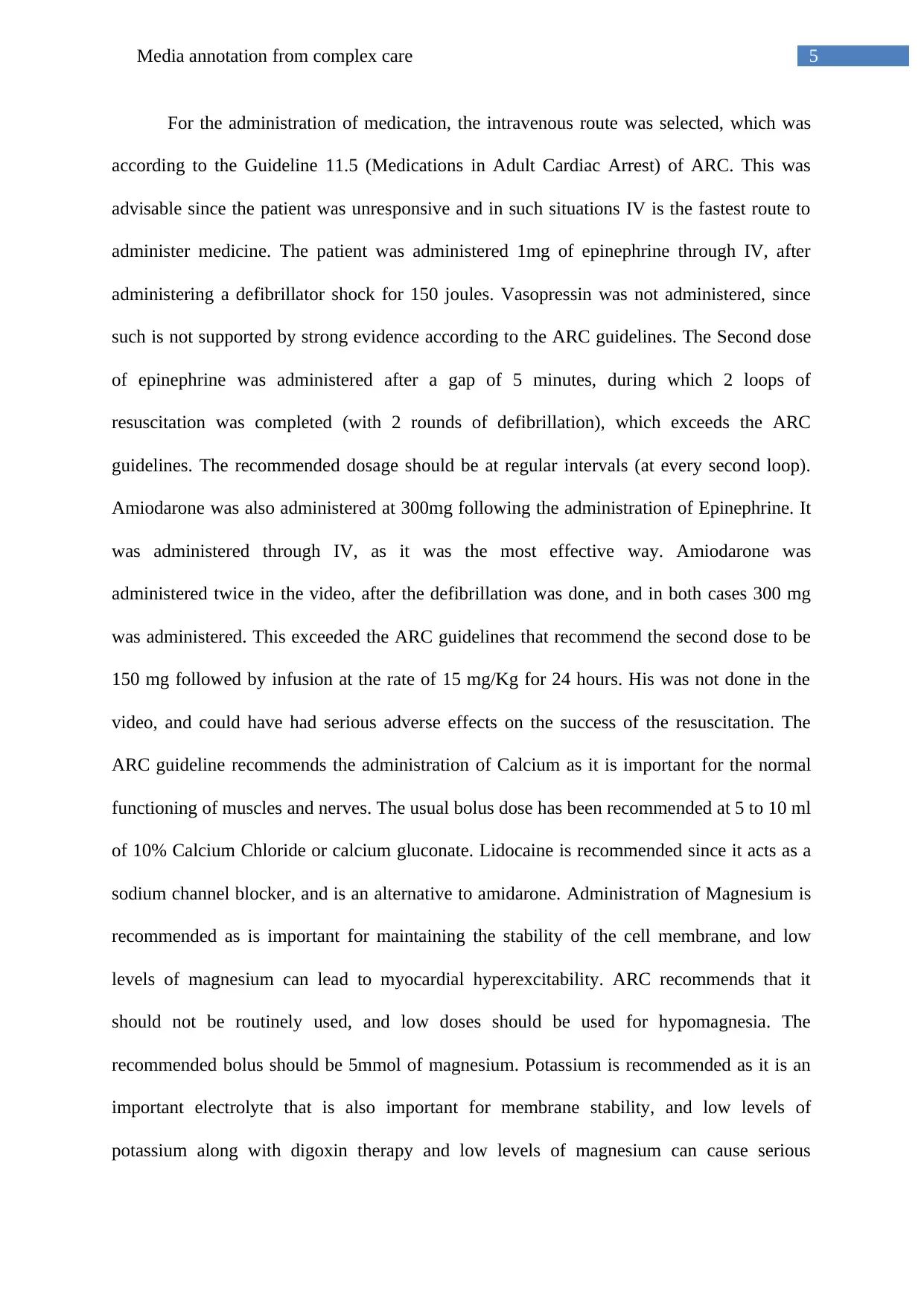
5Media annotation from complex care
For the administration of medication, the intravenous route was selected, which was
according to the Guideline 11.5 (Medications in Adult Cardiac Arrest) of ARC. This was
advisable since the patient was unresponsive and in such situations IV is the fastest route to
administer medicine. The patient was administered 1mg of epinephrine through IV, after
administering a defibrillator shock for 150 joules. Vasopressin was not administered, since
such is not supported by strong evidence according to the ARC guidelines. The Second dose
of epinephrine was administered after a gap of 5 minutes, during which 2 loops of
resuscitation was completed (with 2 rounds of defibrillation), which exceeds the ARC
guidelines. The recommended dosage should be at regular intervals (at every second loop).
Amiodarone was also administered at 300mg following the administration of Epinephrine. It
was administered through IV, as it was the most effective way. Amiodarone was
administered twice in the video, after the defibrillation was done, and in both cases 300 mg
was administered. This exceeded the ARC guidelines that recommend the second dose to be
150 mg followed by infusion at the rate of 15 mg/Kg for 24 hours. His was not done in the
video, and could have had serious adverse effects on the success of the resuscitation. The
ARC guideline recommends the administration of Calcium as it is important for the normal
functioning of muscles and nerves. The usual bolus dose has been recommended at 5 to 10 ml
of 10% Calcium Chloride or calcium gluconate. Lidocaine is recommended since it acts as a
sodium channel blocker, and is an alternative to amidarone. Administration of Magnesium is
recommended as is important for maintaining the stability of the cell membrane, and low
levels of magnesium can lead to myocardial hyperexcitability. ARC recommends that it
should not be routinely used, and low doses should be used for hypomagnesia. The
recommended bolus should be 5mmol of magnesium. Potassium is recommended as it is an
important electrolyte that is also important for membrane stability, and low levels of
potassium along with digoxin therapy and low levels of magnesium can cause serious
For the administration of medication, the intravenous route was selected, which was
according to the Guideline 11.5 (Medications in Adult Cardiac Arrest) of ARC. This was
advisable since the patient was unresponsive and in such situations IV is the fastest route to
administer medicine. The patient was administered 1mg of epinephrine through IV, after
administering a defibrillator shock for 150 joules. Vasopressin was not administered, since
such is not supported by strong evidence according to the ARC guidelines. The Second dose
of epinephrine was administered after a gap of 5 minutes, during which 2 loops of
resuscitation was completed (with 2 rounds of defibrillation), which exceeds the ARC
guidelines. The recommended dosage should be at regular intervals (at every second loop).
Amiodarone was also administered at 300mg following the administration of Epinephrine. It
was administered through IV, as it was the most effective way. Amiodarone was
administered twice in the video, after the defibrillation was done, and in both cases 300 mg
was administered. This exceeded the ARC guidelines that recommend the second dose to be
150 mg followed by infusion at the rate of 15 mg/Kg for 24 hours. His was not done in the
video, and could have had serious adverse effects on the success of the resuscitation. The
ARC guideline recommends the administration of Calcium as it is important for the normal
functioning of muscles and nerves. The usual bolus dose has been recommended at 5 to 10 ml
of 10% Calcium Chloride or calcium gluconate. Lidocaine is recommended since it acts as a
sodium channel blocker, and is an alternative to amidarone. Administration of Magnesium is
recommended as is important for maintaining the stability of the cell membrane, and low
levels of magnesium can lead to myocardial hyperexcitability. ARC recommends that it
should not be routinely used, and low doses should be used for hypomagnesia. The
recommended bolus should be 5mmol of magnesium. Potassium is recommended as it is an
important electrolyte that is also important for membrane stability, and low levels of
potassium along with digoxin therapy and low levels of magnesium can cause serious
⊘ This is a preview!⊘
Do you want full access?
Subscribe today to unlock all pages.

Trusted by 1+ million students worldwide
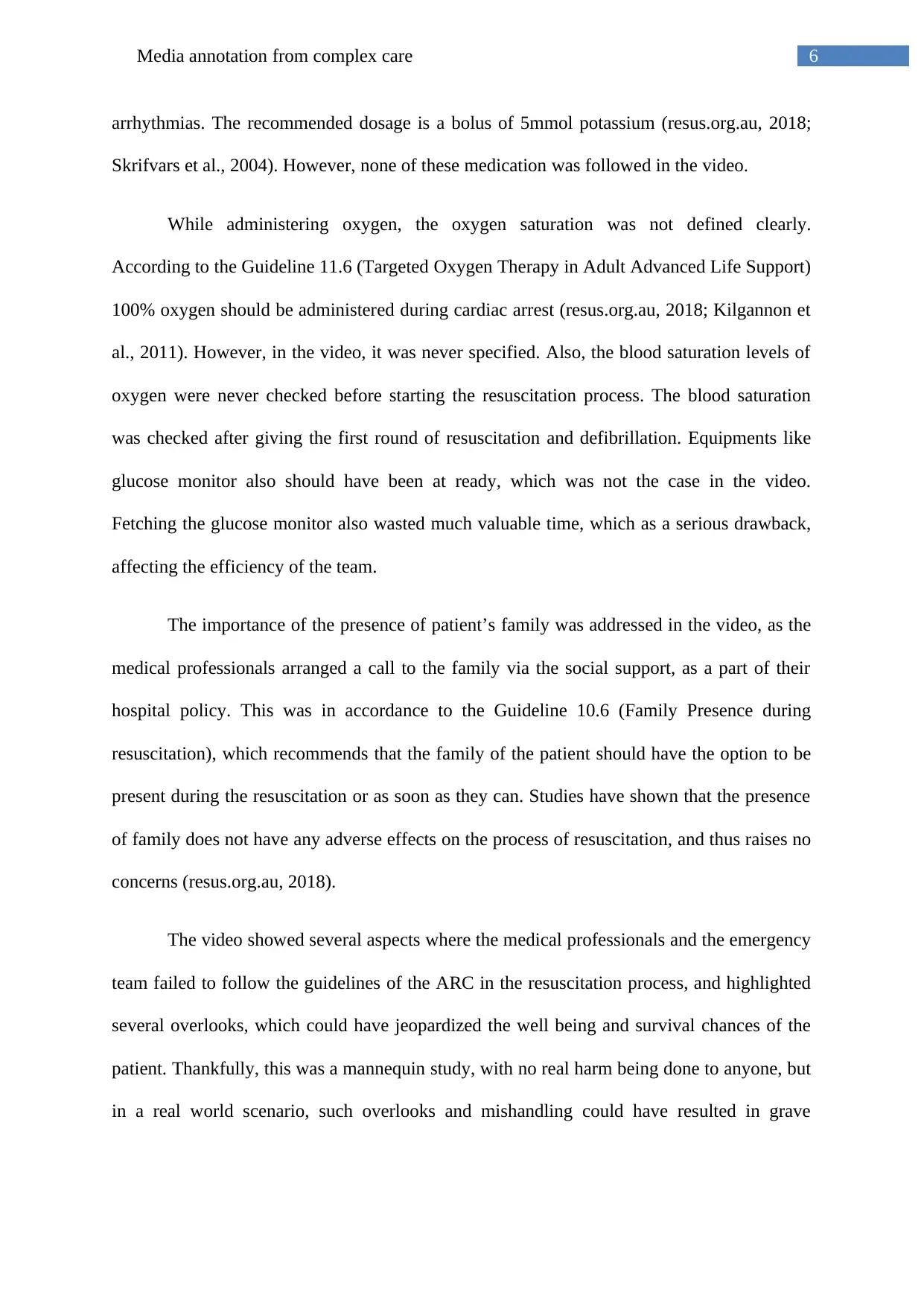
6Media annotation from complex care
arrhythmias. The recommended dosage is a bolus of 5mmol potassium (resus.org.au, 2018;
Skrifvars et al., 2004). However, none of these medication was followed in the video.
While administering oxygen, the oxygen saturation was not defined clearly.
According to the Guideline 11.6 (Targeted Oxygen Therapy in Adult Advanced Life Support)
100% oxygen should be administered during cardiac arrest (resus.org.au, 2018; Kilgannon et
al., 2011). However, in the video, it was never specified. Also, the blood saturation levels of
oxygen were never checked before starting the resuscitation process. The blood saturation
was checked after giving the first round of resuscitation and defibrillation. Equipments like
glucose monitor also should have been at ready, which was not the case in the video.
Fetching the glucose monitor also wasted much valuable time, which as a serious drawback,
affecting the efficiency of the team.
The importance of the presence of patient’s family was addressed in the video, as the
medical professionals arranged a call to the family via the social support, as a part of their
hospital policy. This was in accordance to the Guideline 10.6 (Family Presence during
resuscitation), which recommends that the family of the patient should have the option to be
present during the resuscitation or as soon as they can. Studies have shown that the presence
of family does not have any adverse effects on the process of resuscitation, and thus raises no
concerns (resus.org.au, 2018).
The video showed several aspects where the medical professionals and the emergency
team failed to follow the guidelines of the ARC in the resuscitation process, and highlighted
several overlooks, which could have jeopardized the well being and survival chances of the
patient. Thankfully, this was a mannequin study, with no real harm being done to anyone, but
in a real world scenario, such overlooks and mishandling could have resulted in grave
arrhythmias. The recommended dosage is a bolus of 5mmol potassium (resus.org.au, 2018;
Skrifvars et al., 2004). However, none of these medication was followed in the video.
While administering oxygen, the oxygen saturation was not defined clearly.
According to the Guideline 11.6 (Targeted Oxygen Therapy in Adult Advanced Life Support)
100% oxygen should be administered during cardiac arrest (resus.org.au, 2018; Kilgannon et
al., 2011). However, in the video, it was never specified. Also, the blood saturation levels of
oxygen were never checked before starting the resuscitation process. The blood saturation
was checked after giving the first round of resuscitation and defibrillation. Equipments like
glucose monitor also should have been at ready, which was not the case in the video.
Fetching the glucose monitor also wasted much valuable time, which as a serious drawback,
affecting the efficiency of the team.
The importance of the presence of patient’s family was addressed in the video, as the
medical professionals arranged a call to the family via the social support, as a part of their
hospital policy. This was in accordance to the Guideline 10.6 (Family Presence during
resuscitation), which recommends that the family of the patient should have the option to be
present during the resuscitation or as soon as they can. Studies have shown that the presence
of family does not have any adverse effects on the process of resuscitation, and thus raises no
concerns (resus.org.au, 2018).
The video showed several aspects where the medical professionals and the emergency
team failed to follow the guidelines of the ARC in the resuscitation process, and highlighted
several overlooks, which could have jeopardized the well being and survival chances of the
patient. Thankfully, this was a mannequin study, with no real harm being done to anyone, but
in a real world scenario, such overlooks and mishandling could have resulted in grave
Paraphrase This Document
Need a fresh take? Get an instant paraphrase of this document with our AI Paraphraser

7Media annotation from complex care
outcomes. It is therefore highly recommended that the AR%C guidelines be followed in these
procedures, top ensure the optimum results.
outcomes. It is therefore highly recommended that the AR%C guidelines be followed in these
procedures, top ensure the optimum results.
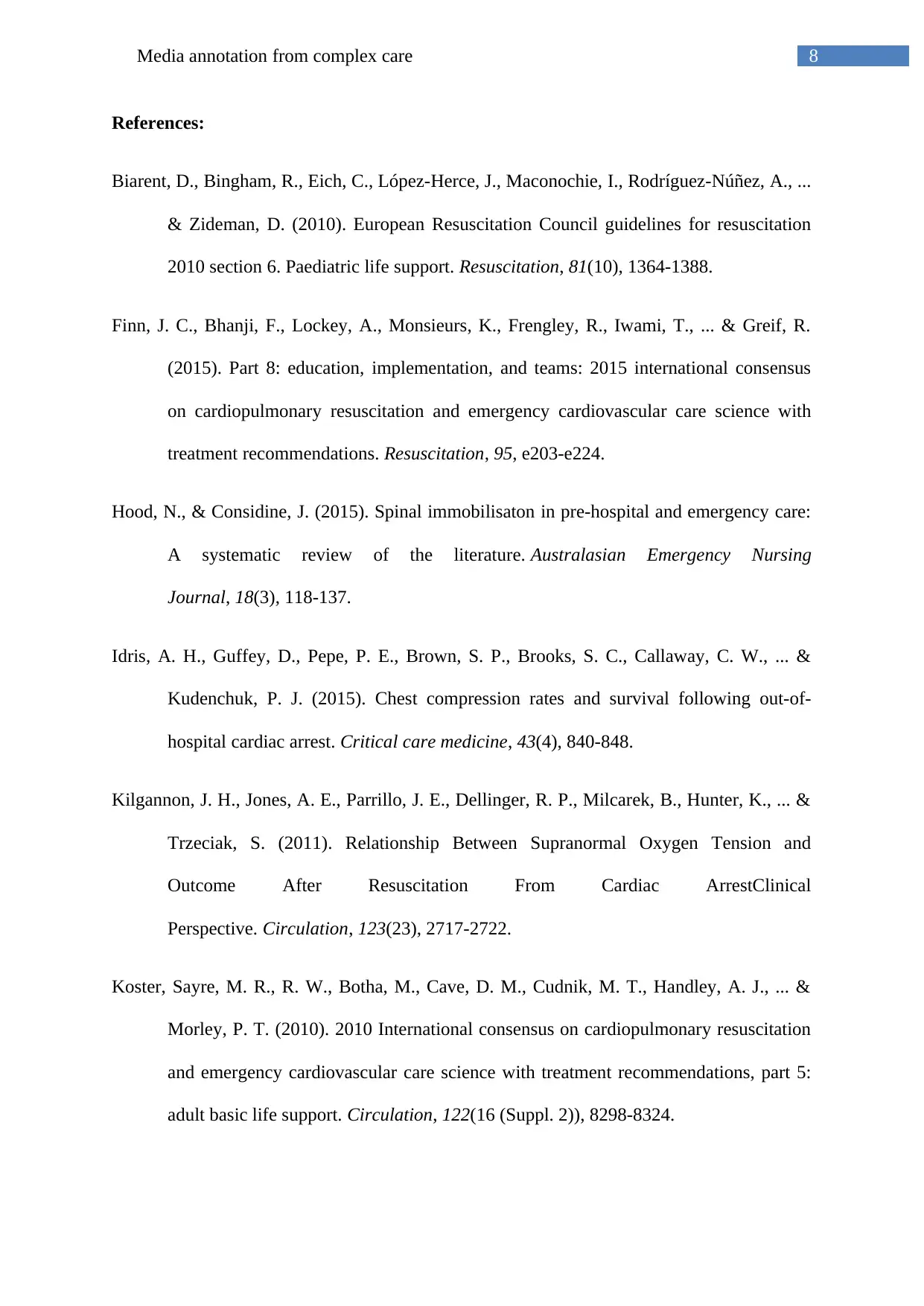
8Media annotation from complex care
References:
Biarent, D., Bingham, R., Eich, C., López-Herce, J., Maconochie, I., Rodríguez-Núñez, A., ...
& Zideman, D. (2010). European Resuscitation Council guidelines for resuscitation
2010 section 6. Paediatric life support. Resuscitation, 81(10), 1364-1388.
Finn, J. C., Bhanji, F., Lockey, A., Monsieurs, K., Frengley, R., Iwami, T., ... & Greif, R.
(2015). Part 8: education, implementation, and teams: 2015 international consensus
on cardiopulmonary resuscitation and emergency cardiovascular care science with
treatment recommendations. Resuscitation, 95, e203-e224.
Hood, N., & Considine, J. (2015). Spinal immobilisaton in pre-hospital and emergency care:
A systematic review of the literature. Australasian Emergency Nursing
Journal, 18(3), 118-137.
Idris, A. H., Guffey, D., Pepe, P. E., Brown, S. P., Brooks, S. C., Callaway, C. W., ... &
Kudenchuk, P. J. (2015). Chest compression rates and survival following out-of-
hospital cardiac arrest. Critical care medicine, 43(4), 840-848.
Kilgannon, J. H., Jones, A. E., Parrillo, J. E., Dellinger, R. P., Milcarek, B., Hunter, K., ... &
Trzeciak, S. (2011). Relationship Between Supranormal Oxygen Tension and
Outcome After Resuscitation From Cardiac ArrestClinical
Perspective. Circulation, 123(23), 2717-2722.
Koster, Sayre, M. R., R. W., Botha, M., Cave, D. M., Cudnik, M. T., Handley, A. J., ... &
Morley, P. T. (2010). 2010 International consensus on cardiopulmonary resuscitation
and emergency cardiovascular care science with treatment recommendations, part 5:
adult basic life support. Circulation, 122(16 (Suppl. 2)), 8298-8324.
References:
Biarent, D., Bingham, R., Eich, C., López-Herce, J., Maconochie, I., Rodríguez-Núñez, A., ...
& Zideman, D. (2010). European Resuscitation Council guidelines for resuscitation
2010 section 6. Paediatric life support. Resuscitation, 81(10), 1364-1388.
Finn, J. C., Bhanji, F., Lockey, A., Monsieurs, K., Frengley, R., Iwami, T., ... & Greif, R.
(2015). Part 8: education, implementation, and teams: 2015 international consensus
on cardiopulmonary resuscitation and emergency cardiovascular care science with
treatment recommendations. Resuscitation, 95, e203-e224.
Hood, N., & Considine, J. (2015). Spinal immobilisaton in pre-hospital and emergency care:
A systematic review of the literature. Australasian Emergency Nursing
Journal, 18(3), 118-137.
Idris, A. H., Guffey, D., Pepe, P. E., Brown, S. P., Brooks, S. C., Callaway, C. W., ... &
Kudenchuk, P. J. (2015). Chest compression rates and survival following out-of-
hospital cardiac arrest. Critical care medicine, 43(4), 840-848.
Kilgannon, J. H., Jones, A. E., Parrillo, J. E., Dellinger, R. P., Milcarek, B., Hunter, K., ... &
Trzeciak, S. (2011). Relationship Between Supranormal Oxygen Tension and
Outcome After Resuscitation From Cardiac ArrestClinical
Perspective. Circulation, 123(23), 2717-2722.
Koster, Sayre, M. R., R. W., Botha, M., Cave, D. M., Cudnik, M. T., Handley, A. J., ... &
Morley, P. T. (2010). 2010 International consensus on cardiopulmonary resuscitation
and emergency cardiovascular care science with treatment recommendations, part 5:
adult basic life support. Circulation, 122(16 (Suppl. 2)), 8298-8324.
⊘ This is a preview!⊘
Do you want full access?
Subscribe today to unlock all pages.

Trusted by 1+ million students worldwide
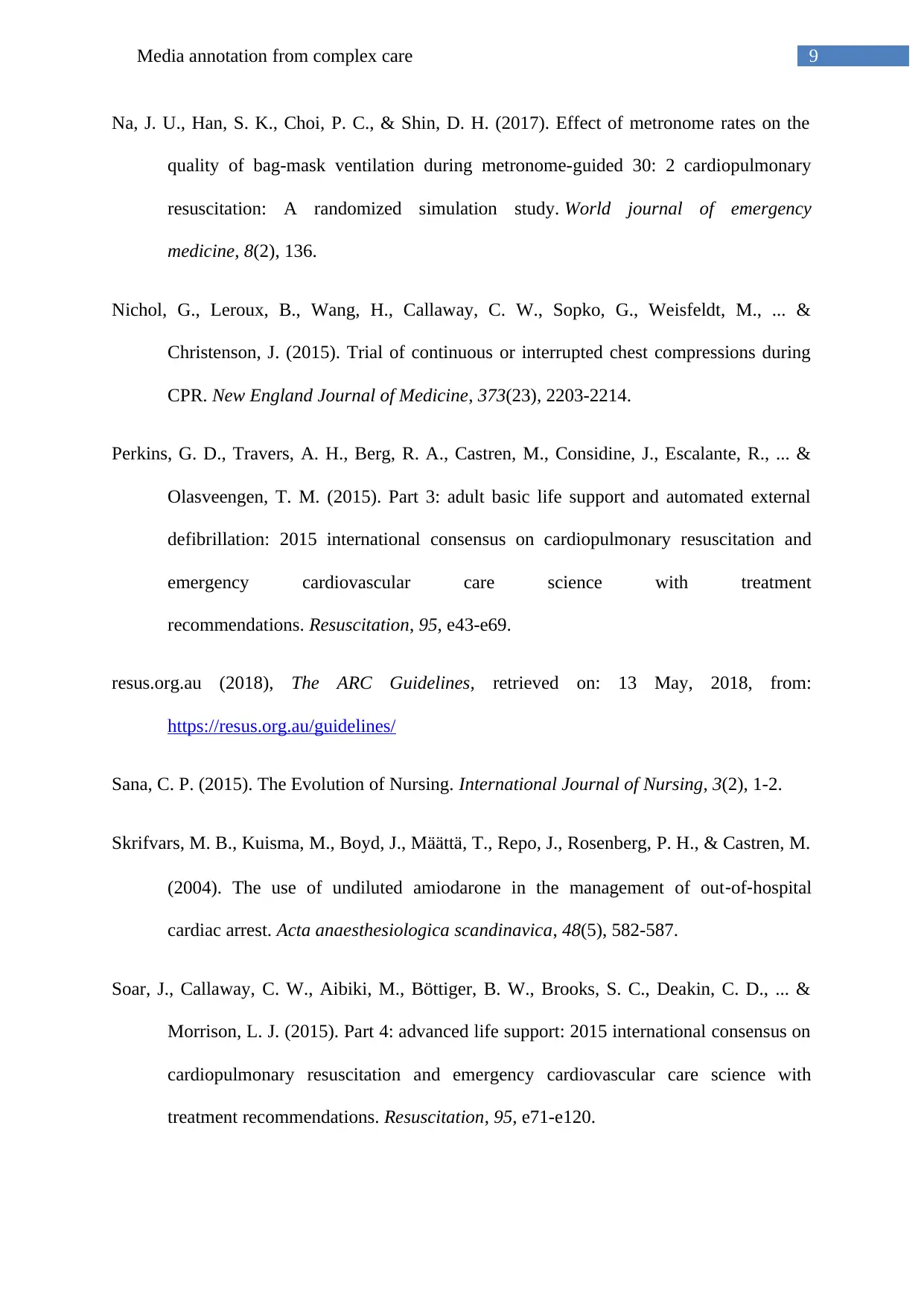
9Media annotation from complex care
Na, J. U., Han, S. K., Choi, P. C., & Shin, D. H. (2017). Effect of metronome rates on the
quality of bag-mask ventilation during metronome-guided 30: 2 cardiopulmonary
resuscitation: A randomized simulation study. World journal of emergency
medicine, 8(2), 136.
Nichol, G., Leroux, B., Wang, H., Callaway, C. W., Sopko, G., Weisfeldt, M., ... &
Christenson, J. (2015). Trial of continuous or interrupted chest compressions during
CPR. New England Journal of Medicine, 373(23), 2203-2214.
Perkins, G. D., Travers, A. H., Berg, R. A., Castren, M., Considine, J., Escalante, R., ... &
Olasveengen, T. M. (2015). Part 3: adult basic life support and automated external
defibrillation: 2015 international consensus on cardiopulmonary resuscitation and
emergency cardiovascular care science with treatment
recommendations. Resuscitation, 95, e43-e69.
resus.org.au (2018), The ARC Guidelines, retrieved on: 13 May, 2018, from:
https://resus.org.au/guidelines/
Sana, C. P. (2015). The Evolution of Nursing. International Journal of Nursing, 3(2), 1-2.
Skrifvars, M. B., Kuisma, M., Boyd, J., Määttä, T., Repo, J., Rosenberg, P. H., & Castren, M.
(2004). The use of undiluted amiodarone in the management of out‐of‐hospital
cardiac arrest. Acta anaesthesiologica scandinavica, 48(5), 582-587.
Soar, J., Callaway, C. W., Aibiki, M., Böttiger, B. W., Brooks, S. C., Deakin, C. D., ... &
Morrison, L. J. (2015). Part 4: advanced life support: 2015 international consensus on
cardiopulmonary resuscitation and emergency cardiovascular care science with
treatment recommendations. Resuscitation, 95, e71-e120.
Na, J. U., Han, S. K., Choi, P. C., & Shin, D. H. (2017). Effect of metronome rates on the
quality of bag-mask ventilation during metronome-guided 30: 2 cardiopulmonary
resuscitation: A randomized simulation study. World journal of emergency
medicine, 8(2), 136.
Nichol, G., Leroux, B., Wang, H., Callaway, C. W., Sopko, G., Weisfeldt, M., ... &
Christenson, J. (2015). Trial of continuous or interrupted chest compressions during
CPR. New England Journal of Medicine, 373(23), 2203-2214.
Perkins, G. D., Travers, A. H., Berg, R. A., Castren, M., Considine, J., Escalante, R., ... &
Olasveengen, T. M. (2015). Part 3: adult basic life support and automated external
defibrillation: 2015 international consensus on cardiopulmonary resuscitation and
emergency cardiovascular care science with treatment
recommendations. Resuscitation, 95, e43-e69.
resus.org.au (2018), The ARC Guidelines, retrieved on: 13 May, 2018, from:
https://resus.org.au/guidelines/
Sana, C. P. (2015). The Evolution of Nursing. International Journal of Nursing, 3(2), 1-2.
Skrifvars, M. B., Kuisma, M., Boyd, J., Määttä, T., Repo, J., Rosenberg, P. H., & Castren, M.
(2004). The use of undiluted amiodarone in the management of out‐of‐hospital
cardiac arrest. Acta anaesthesiologica scandinavica, 48(5), 582-587.
Soar, J., Callaway, C. W., Aibiki, M., Böttiger, B. W., Brooks, S. C., Deakin, C. D., ... &
Morrison, L. J. (2015). Part 4: advanced life support: 2015 international consensus on
cardiopulmonary resuscitation and emergency cardiovascular care science with
treatment recommendations. Resuscitation, 95, e71-e120.
Paraphrase This Document
Need a fresh take? Get an instant paraphrase of this document with our AI Paraphraser

10Media annotation from complex care
Soar, J., Mancini, M. E., Bhanji, F., Billi, J. E., Dennett, J., & Finn, J. (2010). International
consensus on cardiopulmonary resuscitation and emergency cardiovascular care
science with treatment recommendations. Part 12: education, implementation, and
teams. Resuscitation, 81(Suppl 1), e288-330.
Sunde K, Jacobs I, Deakin CD, et al (2010). Part 1: executive summary: 2010 international
consensus on cardiopulmonary resuscitation and emergency cardiovascular care
science with treatment recommendations. Resuscitation, 81(1), e1-e25.
Zideman DA, Singletary EM, De Buck E, et al. (2015), Part 9: First aid: 2015 International
Consensus on First Aid Science with Treatment Recommendations. Resuscitation.
Retrieved on 13 May, 2018 from
http://www.cprguidelines.eu/assets/downloads/costr/S0300-9572(15)00368-
8_main.pdf Accessed 19/11/2015
Soar, J., Mancini, M. E., Bhanji, F., Billi, J. E., Dennett, J., & Finn, J. (2010). International
consensus on cardiopulmonary resuscitation and emergency cardiovascular care
science with treatment recommendations. Part 12: education, implementation, and
teams. Resuscitation, 81(Suppl 1), e288-330.
Sunde K, Jacobs I, Deakin CD, et al (2010). Part 1: executive summary: 2010 international
consensus on cardiopulmonary resuscitation and emergency cardiovascular care
science with treatment recommendations. Resuscitation, 81(1), e1-e25.
Zideman DA, Singletary EM, De Buck E, et al. (2015), Part 9: First aid: 2015 International
Consensus on First Aid Science with Treatment Recommendations. Resuscitation.
Retrieved on 13 May, 2018 from
http://www.cprguidelines.eu/assets/downloads/costr/S0300-9572(15)00368-
8_main.pdf Accessed 19/11/2015
1 out of 11
Related Documents
Your All-in-One AI-Powered Toolkit for Academic Success.
+13062052269
info@desklib.com
Available 24*7 on WhatsApp / Email
![[object Object]](/_next/static/media/star-bottom.7253800d.svg)
Unlock your academic potential
Copyright © 2020–2025 A2Z Services. All Rights Reserved. Developed and managed by ZUCOL.




